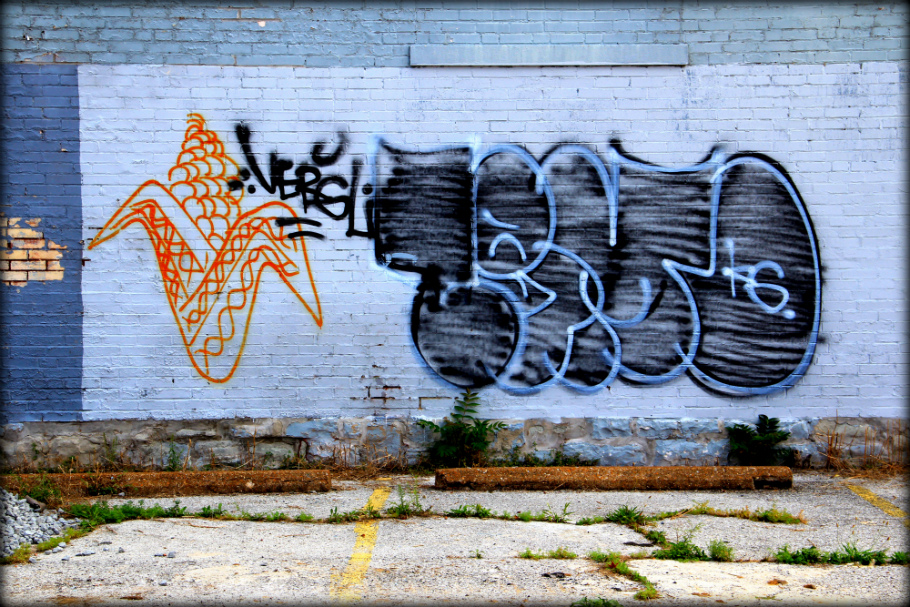
Todd Waelterman’s topped the Streets Department for the last seven years; he’s also about a year shy of a quarter century working for the City of St. Louis. Over those many years, he’s seen (and overseen) a lot of projects. And his memories of Paint Louis at the end of the ‘90s and into the new decade are certainly still fresh in his mind.
“Mayor (Clarence) Harmon was here,” he remembers. “As part of our operation, we maintain the flood walls for the City of St. Louis. That’s a big canvas, a big chunk of wall that people want to hop on and tag. The Mayor routed to us a request to allow painting on the walls near Chouteau. When Paint Louis (originally) happened, it brought in a lot of people who painted on railroad cars and MODOT bridges all over the region. They left us quite a mess. It was a nasty, little mess they left down there.”
For the past two years—as we detailed in our first installment of this series—Paint Louis has returned to the City’s flood walls. This year, Waelterman recalls dealing with John Harrington, who dates back to the earliest days of the event and has been a mainstay of the local hip-hop community.
“Most recently,” Waelterman recalls, “we had a guy come in representing the Paint Louis group, Mr. Harrington. He applied for a public service permit, which allows people to do things in the public right-of-way. If you want to have a street art project with chalk, that’s what you use; we see all kinds of people come in for them. They asked for a no-cost permit and that request goes out to all the City agencies involved, from the cops, to Streets and Forestry. The Streets department has a pretty significant role in this one, because the Streets department controls that wall.
“In trying to work with them and with Mr. Harringson, we asked him to bring some samples down, some concepts of the work they wanted to do,” Waelterman says. “We didn’t want anything crazy, nothing offensive. As long as it’s not real sensitive and looks like artwork, we’d okay it for Mr. Harrington. But the last time these people were in town, they created a lot of havoc. Oftentimes, these artists invite people to join them over the Internet. They had the event down there. And on Monday morning, we received about a half-dozen calls about graffiti going up.”
Then something else happened.
According to Waelterman, “Mr. Harrington stepped up he took ownership of this. He had his own power washer and he went out and worked on them on his own. He’s a real man, he carried through on his promise to do that. And that meant a lot to me.”
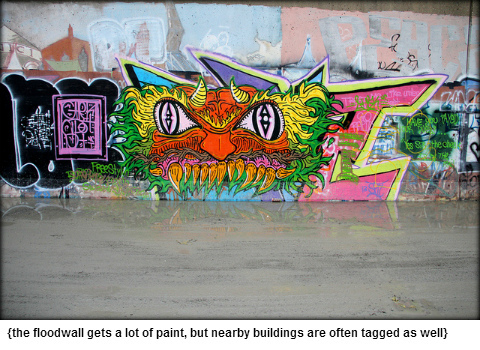 Of course, there’s a lot of graffiti that gets up around St. Louis and most of it is applied by folks who aren’t coming back the next day with their own clean-up equipment. A variety of City agencies get contacted by people who hope for their property to be painted over, or sandblasted. But the majority of the time, the responsibility for the clean-up work’s going to fall under the auspices of Brightside St. Louis, known for so long as Operation Brightside, that even City officials back on the old term.
Of course, there’s a lot of graffiti that gets up around St. Louis and most of it is applied by folks who aren’t coming back the next day with their own clean-up equipment. A variety of City agencies get contacted by people who hope for their property to be painted over, or sandblasted. But the majority of the time, the responsibility for the clean-up work’s going to fall under the auspices of Brightside St. Louis, known for so long as Operation Brightside, that even City officials back on the old term.
The Streets department, itself, fights a constant battle against graf (and, especially, stickers) applied “to stop signs and traffic control boxes. Those contain the gear that controls traffic signals at corner. Those are constantly being covered by stickers and posters, mostly for bands and concerts.”
But that’s ground-level stuff. Some of the graffiti’s done at a height that amazes even those who routinely work against it.
“You’ll see that on a lot of vacant buildings,” Waelterman says. “They get 40 or 50 feet in the air and it’s unbelievable. There are some buildings on Meramec and Gravois like that, ones that people are complaining about. That can get fairly hard to manage. If it’s neat and appropriate, we’ll even leave it up. Which gets into a conversation about what’s art and what isn’t. It’s a very individual type of thing to decide and I’d consider it art as long as it doesn’t offend anyone; and it can’t be inappropriate. Some of these guys put this nasty stuff up, and we can’t tolerate it for the kids. We have to separate out what’s graffiti art and what’s downright junk.”
BRIGHTSIDE IDEAS
Mary Lou Green’s the longtime head of Brightside St. Louis and her days are frequently touched on by the images and backstory of graffiti. Her job, of course, has a large component of anti-graffiti work involved, with many calls for service coming directly to her office; plenty of others are routed via the Citizen’s Service Bureau and/or the City’s 28 Alderpersons. Something obviously annoying to her, though, is the fact that Brightside’s headquarters in the Southwest Garden neighborhood looks across Kingshighway to an old factory complex that’s liberally streaked with graffiti.
As Waelterman suggests above, a lot of the graffiti is done at a height that makes easy removal a near-impossibility. Over the process of working on this subject, I’d been told more than once that there was a 10-foot limit to Brightside fixes; that’s not exactly true.
“It’s as high as we can reach,” Green says. “It’s not actually 10-feet, but if we’re working from the ground level, paintings over a certain height can’t be reached by a roller, or by paint stripper.”
Brightside’s a City of St. Louis agency, which receives half of its funding from the City (through federal block grant dollars) and half from private fundraising sources. All of that allows Brightside to employ a five-man Graffiti Eradication Team; members of that group typically break into two work crews, laboring from 7:00 a.m. to 3:30 p.m. Typically, one crew works on painting over graffiti; the other group, armed with a giant water tub and multiple bags of industrial-grade sand sandblast walls. For these crews, the job is a year-round one, even operating through rain and snow.
Weather aside, changes in the chemistry of the paint and size of pieces are conspiring to making the job a bit trickier.
“They’ve told me that some of graffiti is tougher to get off, which requires a lot more resources on our part,” Green says of her crews. “That’s part of the issue that we’ve had. There’s kind of a trend in the way graffiti’s changed over the years. When we first got into the eradication business, it was a lot of gang-related activity, the marking of territory. It was more of a public safety concern. Over the years, tagging evolved into the more artistic graffiti. Instead of a simple tag on the back of a light pole, or on someone’s garage, which we could easily paint over, it’s now the entire length of a brick wall. And it’s not just outlines, it’s all filled-in. There’s more paint required, meaning more resources on our end, in terms of time, paint, paint-stripper…”
Asked to sketch out some of the costs, Green refers to a few different numbers. For example, she notes that painting and construction companies donate quite a bit of paint. (Individuals cannot donate, for a variety of practical reasons.) But there’s about $20,000 needed annually for items like the shading agents that allow her crews to match paint colors.
“We’re able to do this because of the economies of scale,” she admits. “If someone had to hire a contractor to come in to remove the graffiti, it would cost significantly more than for Brightside to come in to remove the graffiti. We’ve used $4-million dollars over 20 years, plus there’s all the in-kind donations. Those have saved us thousands of dollars that we’ve been able to use towards the program. Just think of the time and cost if property owners didn’t have this service. In the last 20 years, we’ve removed graffiti from 130,000 properties, though, obviously, a lot of those are repeats.”
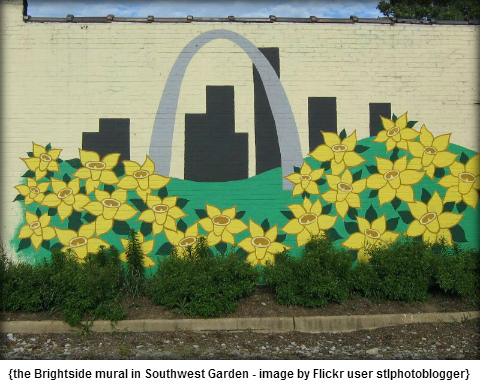
When I tell her of a positive experience passed along to me recently, she says with some evident pride that “People are very pleased with the service we provide.”
Green can easily tick off the ways in which graffiti removal calls come in. As noted above, the three primary ways include: calls to the Citizen’s Service Bureau; calls to Alderpersons; and direct contact with Brightside. For responses to be considered, crews have to be able to access the property; in addition to issues like fencing, height can play a major role in Brightside’s ability to respond and act. There are also places where Brightside doesn’t go as policy; examples of this would include along rail tracks. Metro, for example, asks for Brightside crews to not work alongside tracks, even as these are some of the most-popular places to paint.
On the flipside, Brightside does react to some requests on a priority level, such as when the St. Louis Metropolitan Police Department calls as “there have been times with the Police have contacted us and these (tags) were deemed important by the Police to remove. There can be priority placed on graffiti, based on what’s conveyed in the message and that it needs to be removed quickly. We respond to that.”
Most calls, of course, don’t revolve around these types of issues. They’re more garden variety. And the process moves through set channels.
“We get a request to get the graffiti removed,” she says, moving through a typical contact. “If it’s the property owner who contacts us, they can expedite the process. If we get a call of someone reporting graffiti through CSB, we need to contact the property owner; so we mail a letter of explanation and a consent form. We tell them there’s graffiti on the property and we’ll remove it at no cost. Now, some people never respond. Or the property information isn’t current, or they don’t deal much with the property or are an absentee landlord. We have some people who simply don’t respond. But in the interest of public safety we need to act (without expressed consent), we can. There was an ordinance put in place a few years ago, stating that it can be in the community’s interest for the graffiti to be removed. If after eight days we still haven’t had a response, we do have permission to remove that graffiti.”
While some numbers can be broken down specifically, were someone to ask a per-visit cost of graffiti removal, things get a bit more complicated.
“We don’t break it down specifically by property or address, because some of it might be small, like a tag on a newspaper box,” Green says. “Whereas, the next site can be an entire brick wall.”
Though we don’t initially talk about Paint Louis’ impact on graffiti in St. Louis, the event does become a part of our conversation. Again, in terms of numbers.
“When we’re working down by the flood walls, we try to track it by square footage,” she says. “If we’re doing something two-by-four feet we may not, but if we’re working on an entire wall, we’ll measure it. In the area near the flood wall, we removed 18,000 square feet in the months of June and July.”
The reason for this is that the City targets the area’s nearest the Arch grounds for graffiti removal during June, prior to the Fourth of July crush downtown. This assumes a fairly-thorough clean-up in the area that’s sometimes referred to by the name of the stalled Choteau’s Landing project. What her crews typically don’t do is work on the flood walls, themselves, though that’s not a hard-and-fast rule.
“We have no issue with the flood wall,” Green says, “unless there’s something very graphic and we’re asked to come down and paint over that; it could be language or something else that’s graphic. What happens is that as soon as the graffiti folks are done on that flood wall, they tag all over Downtown. We try to remove all that every year, in advance of Fair St. Louis. With the timing of Paint Louis near the end of June, we’re down there removing it in the beginning of June. And then afterwards, we end up back down there, in the area just east of 7th Street and south of the Arch grounds. This year removed graffiti from 63 locations there in June and July.”
And while Paint Louis tends to grab headlines and attention – both good and ill, depending on your position – most City graffiti takes place well outside of that area. Like on the 4600 block of Spring.
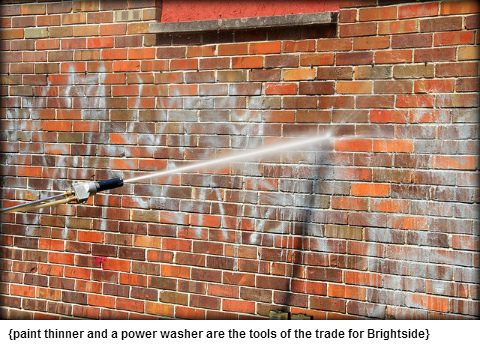 A DRIVE, AND AN EDUCATION
A DRIVE, AND AN EDUCATION
As we drive to two locations of graffiti removal, I mention to Mary Lou Green that I’m becoming almost too-attuned to graffiti lately. That I’m not able to just relax and drive or pedal around the City. Instead, I’m constantly eyeballing new pieces and tags. My rubbernecking’s probably going to cause a fender-bender, or worse. She can empathize.
Getting closer to the first stop, near Beckerle Park and behind St. Mary’s High School, I ask if she noticed a few bits of spray painting from the last few minutes of car time. Remarkably, she ticks off a mental list, the same pieces that had registered with me over the 12-minute drive.
On that drive, she continues to fill me on the two basic forms of graf removal and why each is useful. To witness them, paint-overs are pretty self-explanatory, while sandblasting is best-experienced live, as a long wand sprays the contents of two hoses. One’s emitting sand; the other, water. It might lose visual appeal after a while, but seeing it go live the first time’s interesting enough.
“If it’s on a brick or concrete structure, then we put on paint stripper,” she says. “Then we let that set-up for a bit and use the power-washer to wash it off. We try to maintain the integrity of the building as best we can. If it’s on a vacant or abandoned building and we can’t remove it or will damage (tuckpointing), then we may have to paint over the brick. If it’s already a painted-over surface, then we mark off the area and paint it.”
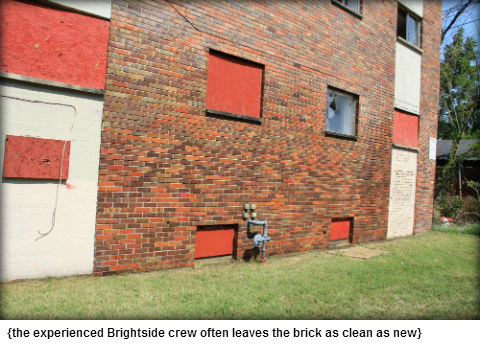 The graffiti on Spring is a rough bit of text, silver spray paint against brick. It’s hard to read for the most part, though the phrase “Fuck Da Police” is unmistakable, directly in the center of the scrawl, which runs for about a dozen, maybe 15 feet. As we arrive on-site, Green greets Jeff and Doug, the graf eradication team’s supervisor; together, these two have roughly 43 years of experience in the job. This strip of wall’s attached to an empty apartment building, one of a series on this parcel of land. In most every way, it’s an unremarkable job site for Jeff and Doug.
The graffiti on Spring is a rough bit of text, silver spray paint against brick. It’s hard to read for the most part, though the phrase “Fuck Da Police” is unmistakable, directly in the center of the scrawl, which runs for about a dozen, maybe 15 feet. As we arrive on-site, Green greets Jeff and Doug, the graf eradication team’s supervisor; together, these two have roughly 43 years of experience in the job. This strip of wall’s attached to an empty apartment building, one of a series on this parcel of land. In most every way, it’s an unremarkable job site for Jeff and Doug.
Jeff preps the wall by applying a coat of paint thinner, scrubbed right onto the brick. Doug follows with the power-washer, the paint thinner’s only on the wall for a matter of minutes. As the water-sand combo hit the walls, thick streaks of grey/silver paint bleed off the wall. As if reading my mind, Green asks if I’d like to take a stab at the job; of course, I do. As Doug hands me the wand, I immediately knock loose one of the hoses; which he quickly re-attaches and I’m back on the job.
As I blast away, the paint continues to bleed off the wall. But some spots are hanging tough, the paint crawling into depressions in the actual brick. So Jeff hits the wall with a bit more thinner. As he does so, I hand off the wand, and Doug pretty much removes every remaining trace. The entirety of the experience is about 20-minutes.
The next stop is on the 5600 block of Delmar. Proving the pyrrhic nature of this activity, the building that’s been hit is slated for demolition, according to some signage placed along the front wall; abandoned now, it’ll come down for a People’s Health center. But the side walls are far too-appealing to graffiti writers, as is. The west-facing side of the building’s got a long tag of Gorgon; a smaller bit of text by Vergl; and what appears to be the head of a corn stalk, among other pieces. This time out, the paint crew’s on-hand, including Vince, Stephen and Richard.
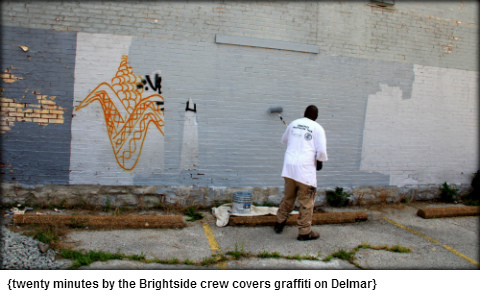 Moving with the efficiency and ease of workers who are used to collaboration, the three toss down some mats, then five-gallon paint buckets, mostly of gray tints. Though the Gorgon piece is a long and thin one, the entire wall including his name gets painted; ditto the Vergl/assumed corn combination. As Green suggests, the square-footage is magnified as the crew attempts to block-out the paint-overs, creating squares and rectangles on a building’s that’s been hit before and may very well be hit again.
Moving with the efficiency and ease of workers who are used to collaboration, the three toss down some mats, then five-gallon paint buckets, mostly of gray tints. Though the Gorgon piece is a long and thin one, the entire wall including his name gets painted; ditto the Vergl/assumed corn combination. As Green suggests, the square-footage is magnified as the crew attempts to block-out the paint-overs, creating squares and rectangles on a building’s that’s been hit before and may very well be hit again.
Asking the crew some questions, they don’t seem to know the Gorgon name. Vergl, yes. The assumed corn stalk, no. It’s not that they don’t want to talk, but… maybe they don’t want to talk, not really, not so much. What they do instead is cover up the various pieces of graf in a matter of minutes; again we clock time on-site at about 20-minutes. They move quickly. Earlier in the day, they were on 13th Street; a stop on Alaska preceded the trip to Delmar.
I ask Green if she and crew ever do chat about what they’re painting over, even in terms of appreciating the obvious risk-taking accompanying some of the pieces.
She says that “we talk extensively about how they can do (these) and no one sees them. It’s obvious the time they’ve taken to put this stuff up on the wall. Yes, definitely we’ve talked about it. I see the artistic talent in some of the graffiti. But as soon as they put it on property that’s not their own, it’s vandalism. That’s what it comes down to for me.”
There’s a sense of concern that media attention on the topic will only bring more.
“Whenever somebody talks about it, it comes around,” she says. “When this was covered on Channel 2, graffiti just exploded around town.”
Asked what she’ll tell a graffiti writer, if ever the opportunity presented itself, she doesn’t need to pause.
“I think, for me, I would ask them ‘why are you doing it,’” she says. “Like I said before, I can see some artistic talent in what you do, but if you could use that for good, it’d make St. Louis a lot better place, rather than causing damage and vandalism. As soon as you use your talent on someone else’s property, you’re vandalizing. You’re a part of the problem. You’re not making St. Louis a cooler, or hipper place. In fact, it’s a place that people want to be less.’”
FOR FURTHER READING AND VIEWING
A local note first. The area politician with the most anti-graffiti streak? It will come as a shock to few. It’s this guy. We hope to chat with him and a colleague, or two, as we go.
Through this process, the word that keeps coming back is that puff paint, normally used by the crafting set, is the en vogue form of small-text applique. Here’s a little primer on puffs.
For those you view large-scale graffiti as a hex on a city, this video by Vice Media will cause a bit of upset. The short doc features Craig Costello, who heads up the Krink brand of paint. The comment section, filled with experts and geniuses, is well worth a scan.
From the “just ‘cause” files, we offer this sight of Paris Hilton buffing walls in heels. We’re sorry that you had to see that.
For next week’s piece, our hope is to go out on a midnight run with an active graf writer. Is that you? Why are you all so elusive? Let’s, like go out, okay?
And, not to be forgotten, are the 47 people who contributed to a Kickstarter campaign funding this project. The check’s not in the bank yet, but this writer couldn’t be more appreciative. To those of you who contributed, please keep an eye out for word of your Kickstarter rewards. THANKS!


